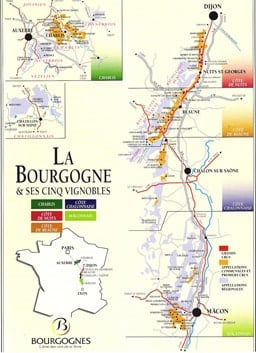
Grape
100% Chardonnay
Facts
- It wasn’t that long ago that Pouilly-Fuisse [poo-yee fwee-SAY] had developed a fairly bad reputation among wine drinkers. Overuse of fertilizers and herbicides in the vineyards resulted in huge crops. These grapes were in turn picked from the vine too early, by the vineyards who were scared about achieving the perfect ripeness levels. The result wasn’t good! Thin, watery, overly acidic wines that due to the Pouilly-Fuissé, name weren’t cheap either!
- You’ll be relieved to know (if you care) that a brand new generation of growers has started to respect the land and the grapes a little. Not to say that these types of shenanigans aren’t still taking place, but competition from New World wines has probably made the French think a little more about what they’re sticking in the bottle!
- I’ve always thought that Pouilly Fuisse has a little-bit of an image problem. It’s one of those wines that will always do well in restaurants. Look at that label above, it looks fancy, right? However; if you were to ask most people (“everyday-drinkers”) the grape in Pouilly-Fuisse, I’d put money on 99% not being able to tell you that it’s Chardonnay.
- The Louis Latour is without question the market leader for Pouilly Fuisse, but they’ve had a good head-start, with their winemaking dating back to the 17th century. The house produces wines throughout the Burgundy region, ranging from $10 retail up to their well-cellared vintage wines reaching to 4-digits.
 Place (click for larger image)
Place (click for larger image)
The Cote D’Or (North) produces primarily red, and the Cote de Beaune (South) produces mainly white. But then you start getting into individual villages, 600+ Premier Cru’s, and 33 Grand Cru’s, and all of a sudden you start to develop a headache as you think about the Master Sommeliers that have to remember it all!
The soil in the region of Burgundy is made up primarily of limestone and clay, which is believed to contribute to a rich mineral taste in the wine.

Taste
Great fragrant nose, floral tones with subtle lemon zest, butter, kiwi, crisp green apple and rich juicy pear. Round and creamy texture in the mouth. Bracing acidity and minerality, balances well with the fruit. A touch of tropical fruit comes through once the wine breathes and warms up. Impressive-persistent finish that will stay with you: kind of like that Lady Gaga song I heard on the radio this morning….I just can’t get it out of my head!!!
Pairing
Why do you always need food? When it comes to pairing though, Pouilly-Fuisse has a relatively heavy mouthfeel, and more of a buttery texture which allows it to be matched with everything from poultry to seafood. Also think about creamy soups, bass, trout, halibut, swordfish, pork, sushi, or simply to be enjoyed as an aperitif.
Price
$18.99



Everyday Taste Buds
This has become my favorite white wine! It took me forever to realize that it is a Chardonnay because it is not your typical oaky, buttery Chardonnay.
-Guy
Kris Chislett
Very true! I think more people would like Pouilly Fuisse if they knew it was Chard. A lot of people seem to be skewing towards subtlety in the Chardonnay.